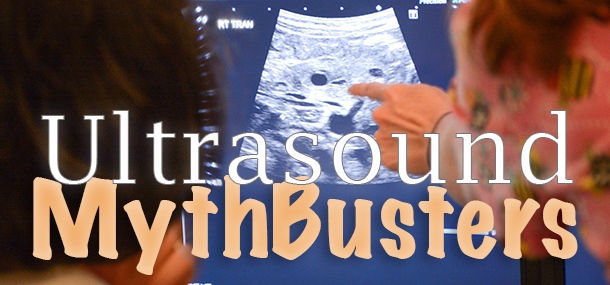
Medical diagnostic sonography, or ultrasound, is a way of taking pictures inside the body. A camera called a transducer creates a picture by transmitting and receiving high-frequency sound waves. Working for several years in the field, I have come across many false statements and confusion regarding ultrasound.
The following are some common myths:
1. “A sonogram is different than an ultrasound.”
True and False – The words have different meanings, but they are used to refer to the same type of procedure. Ultrasound is the actual exam or name of the procedure while sonogram is the image produced from the ultrasound procedure.
2. “Ultrasound is used to take pictures of babies in utero.”
While this statement is true and the most well-known application, there is actually a lot more that can be seen than just babies. At Cincinnati Children’s, the ultrasound department scans a large variety of structures in the body. First of all, our patients range in age from premature infants to adults. For an ultrasound exam of the abdomen, we will look at the liver, gallbladder, spleen, and pancreas. Kidneys and bladder can also be evaluated using ultrasound. Other exams that we complete include vascular exams of the blood vessels, breast, spine, thyroid, neonatal and infant brain, musculoskeletal exams, appendix, scrotum, soft tissue swelling, imaging of transplant organs, pelvic organs (uterus and ovaries), etc.
3. “Ultrasound is a quick exam.”
When an exam is ordered, the technologists have specific pictures that have to be taken in order for the radiologist to give a complete report to the doctor that has ordered the study. Our technologists take pride in providing the radiologists with all the necessary information for a thorough report to assist in diagnosis. While some exams are relatively quick (20 minutes), others may take over an hour. Many factors may increase the time necessary to obtain the images, including patient motion and incomplete prep time.
4. “My child cannot eat before the ultrasound.” Photo: www.morguefile.com
Photo: www.morguefile.com
Not all exams require your child to be without food and drink for a specific period of time. Depending on what we are looking at, some structures in the body (especially in the abdomen) make it necessary to fast for several hours to allow us to best visualize that area. We also use feeding as a distraction during exams for infants. Certain exams require your child to refrain from eating for a period of time before the exam, while others are used as a method to calm very young children during the exam. Your baby can be fed while images are being taken and this helps keep him or her still to reduce motion.
5. “I can’t be in the room while my child is having his/her ultrasound.”
Ultrasound does not use ionizing radiation. It uses sound waves, which have no proven risk of harm to your child or others in the room.
6. “The ultrasound technologist can tell me the results of my child’s exam.”
While the ultrasound technologists know a great deal about anatomy and disease processes, images are reviewed thoroughly by a radiologist (a physician specially trained to “read” these pictures). Since it is the final word of the radiologist that matters to your doctor, the ultrasound technologists are instructed not to give out results. That way, any questions you have about the results of the exam can be discussed with your doctor and, if needed, a treatment plan can be determined.
7. “My child needs to have a full bladder.”
Not all ultrasound exams require your child’s bladder to be full. If we are evaluating the bladder itself, it is better to have it full, for instance when checking the kidneys and bladder during a renal ultrasound. Also, we use the fluid in the bladder to see structures behind it, such as the uterus and ovaries for a pelvic ultrasound. The bladder can sometimes be slow to fill if your child is dehydrated. When scheduling exams requiring a full bladder, you will be given guidelines as to the amount and time your child will need to drink prior to the exam.
We have specific reasons for every study we do. If at any time you have questions, please ask. We are here to help!